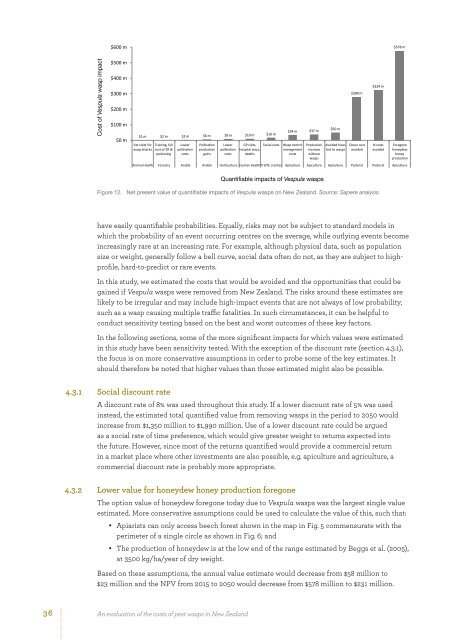evaluation-pest-wasps-nz
evaluation-pest-wasps-nz
evaluation-pest-wasps-nz
Create successful ePaper yourself
Turn your PDF publications into a flip-book with our unique Google optimized e-Paper software.
$600 mNPV 8% real 2015 to 2050 without Wasps$578 mCost of Vespula wasp impact$500 m$400 m$300 m$200 m$100 m$0 m$1 m $2 m $2 m $6 m $9 m $10 m $16 mVet visits for Training, fullwasp attacks cost of ER &poisioningLowerpollinationcostsPollinationproductiongainsLowerpollinationcostsGP visits, Social costshospital stays,deaths$34 m $37 mWasp controlmanagementcostsProductionincreasewithout<strong>wasps</strong>$50 mAvoided hiveslost to <strong>wasps</strong>$280 mClover costavoided$324 mN costsavoidedForegonehoneydewhoneyproductionAnimal Health Forestry Arable Arable Horticulture Human Health Traffic crashes Apiculture Apiculture Apiculture Pastoral Pastoral ApicultureQuantifiable impacts of Vespula <strong>wasps</strong>Figure 12. Net present value of quantifiable impacts of Vespula <strong>wasps</strong> on New Zealand. Source: Sapere analysis.have easily quantifiable probabilities. Equally, risks may not be subject to standard models inwhich the probability of an event occurring centres on the average, while outlying events becomeincreasingly rare at an increasing rate. For example, although physical data, such as populationsize or weight, generally follow a bell curve, social data often do not, as they are subject to highprofile,hard-to-predict or rare events.In this study, we estimated the costs that would be avoided and the opportunities that could begained if Vespula <strong>wasps</strong> were removed from New Zealand. The risks around these estimates arelikely to be irregular and may include high-impact events that are not always of low probability,such as a wasp causing multiple traffic fatalities. In such circumstances, it can be helpful toconduct sensitivity testing based on the best and worst outcomes of these key factors.In the following sections, some of the more significant impacts for which values were estimatedin this study have been sensitivity tested. With the exception of the discount rate (section 4.3.1),the focus is on more conservative assumptions in order to probe some of the key estimates. Itshould therefore be noted that higher values than those estimated might also be possible.4.3.1 Social discount rateA discount rate of 8% was used throughout this study. If a lower discount rate of 5% was usedinstead, the estimated total quantified value from removing <strong>wasps</strong> in the period to 2050 wouldincrease from $1,350 million to $1,990 million. Use of a lower discount rate could be arguedas a social rate of time preference, which would give greater weight to returns expected intothe future. However, since most of the returns quantified would provide a commercial returnin a market place where other investments are also possible, e.g. apiculture and agriculture, acommercial discount rate is probably more appropriate.4.3.2 Lower value for honeydew honey production foregoneThe option value of honeydew foregone today due to Vespula <strong>wasps</strong> was the largest single valueestimated. More conservative assumptions could be used to calculate the value of this, such that:••Apiarists can only access beech forest shown in the map in Fig. 5 commensurate with theperimeter of a single circle as shown in Fig. 6; and••The production of honeydew is at the low end of the range estimated by Beggs et al. (2005),at 3500 kg/ha/year of dry weight.Based on these assumptions, the annual value estimate would decrease from $58 million to$23 million and the NPV from 2015 to 2050 would decrease from $578 million to $231 million.36 An <strong>evaluation</strong> of the costs of <strong>pest</strong> <strong>wasps</strong> in New Zealand


